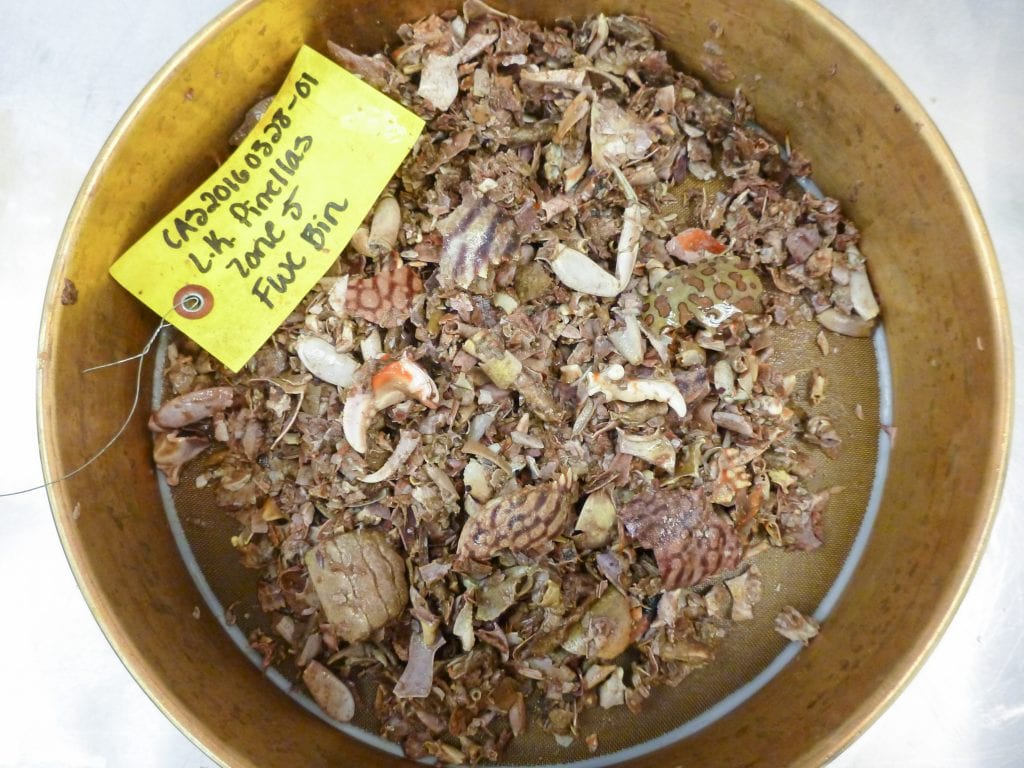
A University of Central Florida biologist who is an authority on what sea turtles eat will present on her work March 18 in a public seminar.
The talk at the Barrier Island Center in Melbourne Beach will focus on what endangered and threatened sea turtles eat, types of habitats they depend upon in Florida, and whether human or environmental activity might put any of those food sources at risk.
Erin Seney, an assistant research scientist in the College of Sciences’ biology department, and her volunteers have been identifying items in the diets of Florida sea turtles for about a year and a half. Seney has conducted similar research in Virginia, and her volunteers, all former summer interns in Seney’s lab, have become adept at determining what turtles have eaten.
“Figuring out what a turtle has eaten is like a puzzle, and it can take a while to work through what the various bits and pieces were before a turtle bit into them,” she said.
Seney and her team rely on carcasses of loggerhead, Kemp’s ridley, and green turtles that die in the wild and wash up on shore or are otherwise found. The Florida Fish and Wildlife Conservation Commission works with Florida Sea Turtle Stranding and Salvage Network members to collect and necropsy the turtles about twice a year. These animal autopsies help wildlife managers understand the causes of death of the turtles and the health of populations.
The research is funded by two awards from a competitive grant program supported by proceeds from the Florida Sea Turtle license plate and could help efforts to protect the three most prevalent sea turtle species in the state.
Results, expected in about a year, can inform the development of policies related to sea turtle habitat and human activities that may impact turtles. Policies could guide development plans, boating, and fishing regulations. All sea turtles are protected, with Kemp’s ridleys listed as endangered and both green and loggerhead turtles listed as threatened under the U.S. Endangered Species Act.
Last fall during a trip to Eckerd College’s Marine Mammal Pathology Laboratory in St. Petersburg, Seney and biology undergraduate volunteer Kayla Burandt collected the stomach and intestinal contents of 45 “strandings” or turtles that washed up on shore and were either dead or in such a deteriorated state they were beyond rehabilitation.
Seney and Burandt collected their samples after FWC and National Marine Fisheries Service personnel necropsied each turtle to examine its body condition and health and determine any probable cause of death.
Once the diet samples are collected at each session, the team takes them back to the lab at UCF where they are examined visually.
So what do they find?
Loggerheads, averaging about 250 pounds and named for their large, muscular heads, are meat eaters. Their digestive tracts typically contain the remains of crabs, snails, clams, and other shellfish that were crushed by their powerful jaws.
The Kemp’s ridley, quite a bit smaller with an adult weight of 75-100 pounds, are also equipped with powerful jaws and use them to devour a variety of shellfish, including blue crabs and hermit crabs.
Green turtles, which often reach 300-350 pounds, are the only herbivores of the bunch, preferring seagrasses and macroalgae. In addition to using visual identification, Seney is also working with Anna Forsman of the UCF Genomics and Bioinformatics Cluster, and Madison Hall, a doctoral student in the UCF Physiological Ecology and Bioenergetics Laboratory, on a pilot study to use genetic “barcoding” to better identify green turtle diet components. The technique focuses on specific sections of the food items’ DNA, which are replicated, sequenced, and compared to DNA databases to identify what was in each sample.
“It takes a certain kind of person to do this work,” Seney said. “A turtle necropsy is not something most people could stomach.”
Seney, who was fascinated by turtles as a child, got the bug to study their diets while pursuing her master’s degree in marine science at the College of William & Mary in Virginia. She went on to earn a doctorate in wildlife and fisheries sciences at Texas A&M University and later served as a fellow of the American Association for the Advancement of Science and Technology Policy at the National Science Foundation and National Marine Fisheries Service headquarters.
Ultimately, however, she knew she had to come to Florida. Florida is home to the largest loggerhead nesting population in the world and the largest green turtle population in the country. Between June and December, hundreds of thousands of sea turtle hatchlings emerge along the state’s east coast.
And UCF has one of the longest-running and most recognized sea turtle research programs in the country. The Marine Turtle Research Group, founded by Professor Emeritus Llewellyn “Doc” Ehrhart and now led by Kate Mansfield, an assistant professor in the biology department, focuses on research, education, and scientific advisory service related to sea turtle ecology.
The group has monitored sea turtle nesting on Brevard County beaches since 1982, and its first decade of data collection played a large role in the establishment of the Archie Carr National Wildlife Refuge in Melbourne Beach. The lab has also conducted year-round monitoring of the Indian River Lagoon’s sea turtle populations since 1982, giving it one of the longest continuous in-water sea turtle datasets in the world.
Seney plans to add to the group’s work by publishing results from her diet work in the next couple of years.
“Knowing what an animal eats is crucial to understanding its habitat needs and potential threats. Because food availability and diets can change over time, up-to-date data are critical for making well-informed sea turtle conservation decisions.”
More information about the March 18 talk is available here.
